
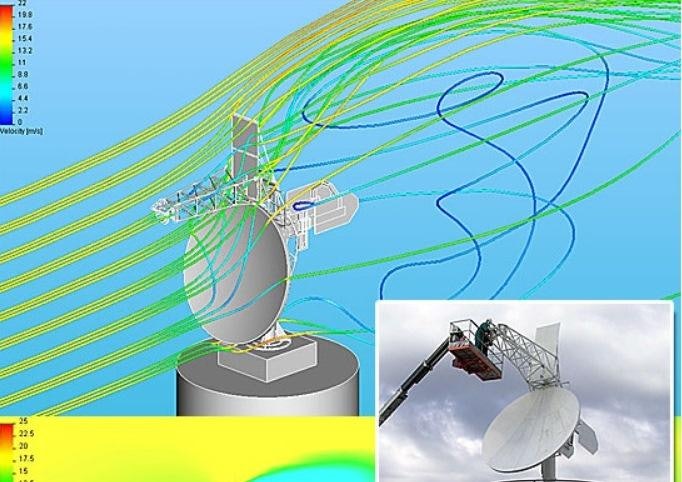
 HOW THE MICROPROCESSOR SATELLITE
HOW THE MICROPROCESSOR SATELLITE
What's Microprocessor?
- Microprocessor or CPU is the "brain" which is the main controlling all operations in the satellite system. Microprocessor taking the binary instructions from memory, translated into a series of action and run it. The action could be a transfer of data to and from memory, arithmetic and logic operations, or the generation of control signals.
 FIGURE 1
FIGURE 1
MICROPROCESSOR SATELLITE
SATELLITE POSITION
Position of the satellite in its orbit is divided into 3 kinds.
- 1. Low Earth Orbit (LEO): 500 to 2.000 km above the earth's surface.
2. Medium Earth Orbit (MEO): 8.000 to 20.000 km above the Earth's surface.
- 3. Geosynchronous Orbit (GEO): 35.786 km above the Earth's surface.
HOW THE SATELLITE
 Phase I. The satellite receives radio signals from earth stations (up link)-
Earth stations transmit data that has been in the encoding into a radio
signal, via a parabolic reflector is emitted towards the satellite. , Earth station antenna is placed on the outdoor section in the
direction of a straight line to the satellite (line of sight) without
any obstructions.-
The transmitter creates a powerful burst of energy in the form of radio
waves that can travel through the Earth's atmosphere to a satellite in
space, satellite antenna is a tool such as the curved dish (parabolic
antenna) receives a radio signal transmitted from the earth station
antenna. The radio signal is emitted in the power spectrum at a predetermined frequency satellite communications system used.II. Signal processing stage in the transponder· The radio signals being picked up by a satellite antenna forwarded to the transponder. In the transponder radio signal is processed by a variety of electrical components such as the following:· Input select band pass filter limits band / frequency range of the
input radio signal on the uplink, passing frequencies within a certain
range that is applied to the system and reject (attenuate) frequencies
outside that range.· LNA (Low Noise Amplifier), amplify the input radio signal is weak
because of large distances traversed the received radio signals from the
ground station·
Frequency translator, expand and convert the received radio frequency
signal (uplink) to the specified frequency for the transmitted signal
(down link frequency) to a ground station. This is so the signal uplink and down link signals flow with their own, not diffuse.· Power amplifier in the form of a traveling wave tube or a Travelling
Wave Tube (TWT) so it is also known as TWTA (Traveling Wave Tube
Amplifiers) or solid state amplifier is a special vacuum tube amplify
radio frequency (RF) signals to high power.· The band pass filter selects the output frequency range limit output
in the downlink radio signal, radio signal passed with a certain
frequency range· Demux (demultiflexer) is a digital switch with a single input (source) and multiple outputs (destinations). Signal at the input will be routed to the output (channel) which depends on the control on the part of its Select.
Phase I. The satellite receives radio signals from earth stations (up link)-
Earth stations transmit data that has been in the encoding into a radio
signal, via a parabolic reflector is emitted towards the satellite. , Earth station antenna is placed on the outdoor section in the
direction of a straight line to the satellite (line of sight) without
any obstructions.-
The transmitter creates a powerful burst of energy in the form of radio
waves that can travel through the Earth's atmosphere to a satellite in
space, satellite antenna is a tool such as the curved dish (parabolic
antenna) receives a radio signal transmitted from the earth station
antenna. The radio signal is emitted in the power spectrum at a predetermined frequency satellite communications system used.II. Signal processing stage in the transponder· The radio signals being picked up by a satellite antenna forwarded to the transponder. In the transponder radio signal is processed by a variety of electrical components such as the following:· Input select band pass filter limits band / frequency range of the
input radio signal on the uplink, passing frequencies within a certain
range that is applied to the system and reject (attenuate) frequencies
outside that range.· LNA (Low Noise Amplifier), amplify the input radio signal is weak
because of large distances traversed the received radio signals from the
ground station·
Frequency translator, expand and convert the received radio frequency
signal (uplink) to the specified frequency for the transmitted signal
(down link frequency) to a ground station. This is so the signal uplink and down link signals flow with their own, not diffuse.· Power amplifier in the form of a traveling wave tube or a Travelling
Wave Tube (TWT) so it is also known as TWTA (Traveling Wave Tube
Amplifiers) or solid state amplifier is a special vacuum tube amplify
radio frequency (RF) signals to high power.· The band pass filter selects the output frequency range limit output
in the downlink radio signal, radio signal passed with a certain
frequency range· Demux (demultiflexer) is a digital switch with a single input (source) and multiple outputs (destinations). Signal at the input will be routed to the output (channel) which depends on the control on the part of its Select.
III. Phase Satellites transmit / re transmit the radio signals to Earth (down link)·
The radio signals that have undergone a process of refinement,
strengthening and setting specific down link frequency will be
transmitted back to Earth via a satellite antenna. In the process of satellite communications signals no change. The transmitted signal remains the same as it is received. All
the satellite has an onboard computer to control and monitor different
systems - depending on satellite systems such as radios and antennas. All systems have an attitude control system that makes satellite is working properly.· The radio signals sent back by the satellite to a ground station
signal sender or to another earth stasion appropriate allocation
functions and satellites that have been set in the making.·
The signals received by the earth station antenna and decoded by a
decoder tool is then processed by a computer system for their designated
purpose.
Illustration of signal levels ranging from the sender, satellites to receivers on earth.

X . I
understanding Waves
Waves are vibrations that propagate. The hallmark of each wave is a wave energy propagation . In
wave mechanics, it is shown when energy is propagated through water
waves capable of moving the original cork floating quietly on the
water's surface. ships at sea are often caused by ocean waves prove the amount of energy carried by the waves. Heat from the sun feels on earth we are also caused by electromagnetic
waves emitted by the sun propagate or radiate heat energy to the earth.Meanwhile,
the transport of energy through electromagnetic waves without realizing
its benefits are commonly enjoyed in everyday life. For example, one can enjoy the music of distant radio station for their radio waves that carry sound energy that music.Thanks to the micro wave, someone can give orders to his company officer and control only of a cell phone. All means of communication is made possible through electromagnetic
waves, which can transport energy information to various places.- Various WavesBased on the direction of vibration:
A transverse wave, the wave direction of vibration perpendicular to the direction propagation.
Longitudinal waves, the wave direction of vibration in the direction propagation.
Based on how the vines and the medium through which:
Mechanical waves, which are propagated waves and wave mechanics necessary for propagation medium.
Electromagnetic waves, the waves are propagated is the electric field magnet, and is not required medium.
Based on the amplitude:
Wave, the wave amplitude is fixed at a point in its path.
Stationary wave, the wave amplitude is not fixed at a point in its
path, which is formed from the interference of two waves coming and
reflected that each have the same frequency and amplitude but opposite
phase.
From some of the information the author tries to find some benefits in particular for electromagnetic waves waves
Identification of Electromagnetic WavesElectromagnetic waves are waves that can propagate even if there is no medium. Electromagnetic
energy travels in waves with some characters that can be measured,
namely: wavelength / wavelength, frequency, amplitude / amplitude,
speed. Amplitude is the height of the wave, while the wavelength is the distance between two peaks. Frequency is the number of waves passing through a point in unit time.The frequency depends on the speed of the wave climbed. Because electromagnetic energy is a constant velocity (speed of light), wavelength and frequency is inversely proportional. The longer a wave, the lower the frequency, the shorter the wave and the higher frequencies.Electromagnetic energy emitted or released, by all the time in the universe in which different levels. Higher levels of energy in an energy source, the lower the wavelength of the energy produced, and the higher frequencies. Different characteristics of the wave energy is used to classify electromagnetic energy.- Characteristics of Electromagnetic Waves
Changes in electric field and magnetic field occurs at the same
time, so that the two fields have a maximum and minimum prices at the
same time and in the same place.
Direction of the electric field and magnetic fields perpendicular
to each other and both perpendicular to the direction of propagation.
Of characteristic No. 2 shows that the electromagnetic waves are transverse waves.
Like the waves in general, an incident electromagnetic wave reflection, refraction, interference, and diffraction. Also an incident polarization because it includes a transverse wave.
Rapid propagation of electromagnetic waves depends only on the properties of electric and magnetic medium is taken.
- Spectrum of Electromagnetic WavesThe composition of all forms of electromagnetic waves by wavelength and frequency is called the electromagnetic spectrum. Examples of the electromagnetic spectrum:1) Wave RadioThe radio waves are classified according to wavelength or frequency. If the wavelength is high, then surely the low-frequency or vice versa. Radio frequency ranging from 30 kHz up and grouped according to the width of the frequency. The radio waves generated by electric charges are accelerated through conductive wires. Charges are generated by an electronic circuit called an oscillator. The radio waves emitted from the antenna and received by an antenna anyway. You can not hear the radio directly, but will change the radio receiver first wave energy into sound energy.2) MicrowavesMicrowaves (microwaves) are radio waves with the highest frequency is above 3 GHz. If the microwaves are absorbed by an object, it will appear the warming effect on the thing. If the food absorb microwave radiation, the food hot in a very short time interval. This process is used in a microwave oven to cook food quickly and economically.Microwaves
are also used on aircraft RADAR (Radio Detection and Ranging) RADAR
means finding and determine the trace of an object by using microwaves. Aircraft radar utilizing the reflectance properties of microwaves. Due to the rapid propagation of electromagnetic wave c = 3 X 108 m
/ s, then by observing the time interval between transmitting the
reception.3) Infrared raysInfrared light covers an area up to 1014 Hz 1011Hz frequency or wavelength regions 10-4 to 10-1 cm cm. if
you check the spectrum produced by an incandescent lamp with a detector
which is connected to the miliampere meter, then the needle ampere meter
slightly above the red end of the spectrum. Rays are not visible but can be detected above the red spectrum is called infrared radiation.Infrared rays produced by electrons in molecules vibrate because to hot objects. So any hot objects emit infrared rays certainly. The amount of infrared light emitted depends on the temperature and color of objects.4) Visible lightVisible
light as electromagnetic radiation that is most familiar to us can be
defined as part of a spectrum of electromagnetic waves that can be
detected by the human eye.
visible wavelengths depending on the color wavelengths ranging from
approximately 4 x 10-7 m to light violet (purple) to 7x 10-7 m for red
light. Usefulness light one of them is use of lasers in optical fiber telecommunications and medicine.5) UltravioletUltraviolet light has a frequency in the range 1015 Hz to 1016 Hz or in a wave of 10-8 m long area 10-7 m. The waves generated by atoms and molecules in electric flame. The sun is source .
Application of Electromagnetic Waves
The radio waves emitted from the transmitting antenna and received by the receiving antenna. The area is covered and the resulting wavelengths can be determined by high and low antenna. Radio waves can not directly be heard, but this energy is to be converted into sound energy by air as a radio receiver. The use of radio waves for communication are shown in the following figure
Television waves have higher frequencies than radio waves. This television waves propagate straight, can not be reflected by the layers of the earth's atmosphere. Television waves is widely used in the fields of communications and broadcasting. In the process of catching telecast often necessary liaison station (relay) in order to arrest the picture and sound better..
Micro-wave (microwave) has a frequency of 3 GHz. Microwaves can be used for communication tools, cooking, and radar. Radar is an acronym for Radio Detection and Ranging. Radar antenna can act as a transmitter and receiver of electromagnetic waves. At the air base, the radar transmitter antenna can rotate in all directions to detect aircraft heading or leave the air base. In the field of transport, the radar waves are used to help smooth air traffic in the air base or airport. Wave radar is used also in the field of defense is to equip
fighter aircraft so they can know the whereabouts of the enemy planes.
The infrared light is the result of vibrational or rotational transitions in molecules. Infrared
light includes electromagnetic waves having a frequency infrared light
is not visible to the naked eye but visible infrared rays can be
detected by using plates of a particular film that is sensitive to
infrared waves. High-flying aircraft or satellites can make image photo the earth's surface, using infrared waves. As well as ultraviolet rays and visible light, infrared rays are
also widely used in the field of spectroscopy to determine the elements
in the material.
Visible light is often also referred to as light. Visible
light includes electromagnetic waves having a frequency between
ultraviolet rays is the result of transitions of electrons in atoms or
molecules skin. The sun is a natural source of visible light. Visible light is composed of a variety of colors, from red, orange, yellow, green, blue, and purple. We can all see the color of the object because the object reflects these colors and go back to our eyes. Many
applications of light in our lives, among others, by the light we can
see the beautiful scenery, we can take pictures so that the picture
becomes colored as the original, we can see a color television, and so
on. As well as ultraviolet light, visible light is widely used also in
the field of spectroscopy to determine the elements in the material.
Ultraviolet
rays including electromagnetic waves having a frequency of ultraviolet
light is the result of transitions of electrons in atoms or molecules
skin. Ultraviolet
rays do not appear visible to the naked eye but these rays can be
detected by using plates of a particular film that is sensitive to
ultraviolet waves. The sun is a natural source of ultraviolet radiation. Ultraviolet light produced by the sun is not good health, especially if the human skin. Humans
are protected from ultraviolet rays of the sun because of the ozone
layer in the atmosphere that absorbs ultraviolet rays. Applications ultraviolet light is widely used in laboratory
research spektroskopi field, one example to determine the elements
present in certain materials.
X-rays discovered by Wilhelm Conrad Rontgen in 1895 so it is often referred to as the Rontgen rays. X-rays including electromagnetic waves having a frequency between
X-ray is the result of the transition electron electron in the inner skin, the transition occurs in the atom. X-rays have the second largest after the penetrating power of gamma rays. X-rays can penetrate human flesh. Rays are often used in the medical field to check patients .
X . II
Working mode satellite
Working mode COSPAS-SARSAT satellite
Real time above 121.5 MHz repeater system: a satellite repeater on 121.5 Mhz transmits signals directly to the LUT station without going through the process. LUT and EPIRB must be within direct view of the satellite, a new signal can be processed in the LUT position.
Real time data is 406 Mhz proccessed system: Satellite receives signal 406 MHz, the data is immediately processed dopper position by shifting frequency, position data are transmitted to the LUT station located at a distance of vision.
Global 406 Mhz Coverage Mode: By storing the data on the position beacons COSPAS memory, these satellites can provide data on the position of the signs on all active in cross LUT.


Diagram sattelite com
 Figure Assigned Frequency in NBDP system
Assigned Frequency is the center frequency emitted by adding or subtracting a frequency of approximately 85 Hz to form the Space and Mark.
Figure Assigned Frequency in NBDP system
Assigned Frequency is the center frequency emitted by adding or subtracting a frequency of approximately 85 Hz to form the Space and Mark.
Carrier Frequency is the carrier wave to be modulated by Telex system using Frequency Shift Keying (FSK).
the concept of a bird's wing
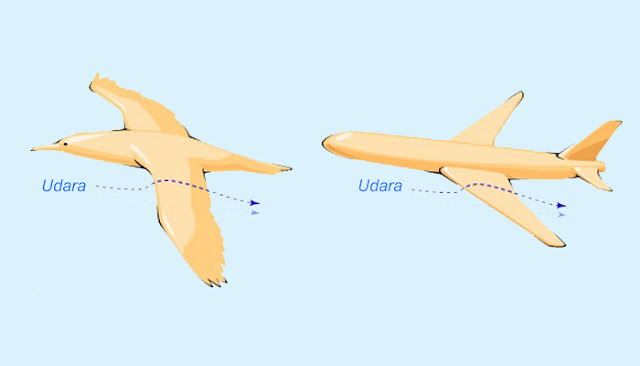 X . I
Why Birds Can Fly?
X . I
Why Birds Can Fly?
Since time immemorial, man has been watching birds fly and wondered how they could do it. The studies done to find out the secret of how birds can fly. Observation and research subsequently made man could make a flying machine called the aircraft.
Birds have a lot of things in the body that can make it fly. It looks like the bird was set up to be animals that can float in the air. Although there are several types of bird family members who do not have the ability to fly like a penguin, chicken, dodo, and ostrich.
Why Birds Can Fly?
From the biology of birds able to fly because it has several factors, including:
1. Wings, functioning lift her into the air.
2. Bones and lightweight frame composition compared to other living beings.
3. The muscles strong chest and stretched its wings to flap, so it can withstand the pressure of the air.
4. Bone big and heavy on the chest and shoulders, to supplement the strength of the wings of birds.
5. purse air in his body, functioning regulate breathing and keep the bird's body to keep it light.
6. Feathers to hold air.
In terms of physics, the ability to fly the bird to come by because the birds were able to do some things in:
1. aeoro foil shaped wings.
2. Being able to generate pressure on the air under its wings.
How Do Birds Fly?Birds get upward lifting force to push himself up with his feet and flapping its wings. When a bird's wings flapping, the air will be pushed down. This push-down will produce the opposing forces so that the bird's body will be lifted into the air. This principle is in accordance with Newton's Law 3. Lift up is usually referred to as a lift.
Trust or thrust forward serves to increase the speed of flying birds is also produced from flapping. In some bird species is obtained from the speed wingspan developed. Increasingly wingspan greater the speed of flying birds. Birds with small wings gain flying speed of the speed of their flapping wings.
Tails in birds serves to accelerate when flying. By leveraging could turn tail and swooping birds. Another function of the birds is as landing aids. When birds straightened and develop wings and tail, the air will be captured, allowing the birds to land softly.
X . II
the effect of flying owl
No privilege owls catch their prey without sounding.
"Owls hunt at night, that's all visual information is limited because of the darkness," Therefore owl has excess detect prey to the sense of hearing, it only works if they fly not ring. "
owl wing aerodynamics research. He discovered, it turns out the birds Hoarse Java or white owl weighs almost the same as doves. But the wings are larger and thicker hairy. "It allows the bird to remain afloat in the air even in low-speed flight," he continued.
Pigeons should be more often flapping its wings. Therefore, the sound of pigeons flying can already be heard from a distance. In contrast to the owl almost no friction between hairs, and it has fewer sounds.
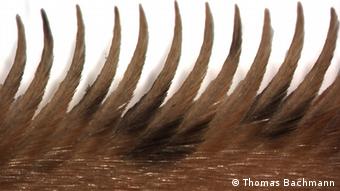 cross-section of the front side of the wing owl
Sharks Effect On owl
cross-section of the front side of the wing owl
Sharks Effect On owl
Owl feather structure is also different from other types of bird feathers. On the front side of the wing, fur lined up and formed a line like hooks. The surface was very soft bristles create micro turbulence on the surface of the wing.
delicate tassels on the end of a feather
delicate tassels on the end of a feather
Similar to shark skin rough surface that minimizes friction with water, micro turbulence increases the stickiness of the airflow on the surface of the wing owl.
Then there are tassels on the ends of the feathers. Its function is to minimize the noise, because each feather each other more refined ride. The other function is more subtle friction between the air flow with the top and bottom in the rear wing on the delicate tassels.
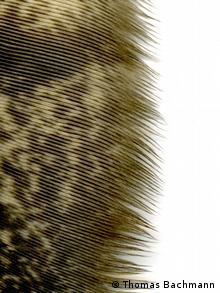 delicate tassels on the end of a feather
Jet Aircraft Modelling Stork
delicate tassels on the end of a feather
Jet Aircraft Modelling Stork
Privileged owl wings could not easily be applied to the construction of civil passenger aircraft. One reason is the speed to fly owl hunting only ten to 15 km / h. But the physical principles can be directly transferred to the aviation technology. For example in the development of vane windmill or turbine with virtually noiseless.
In contrast, more aircraft technology uses the principle of a bird's wings to fly other types. For example winglets at the wing tips of commercial aircraft. Small vertical fin on the wing tips are useful to keep separate the
high pressure on the underside of the wing and low pressure at the top
of the wing that had to be met at the end of the wing and cause
turbulence and slowing the pace of aircraft.
Small indentations on the wingtips were created by imitating the wings of vultures, eagles and storks. "These birds have feathers that grow in line. By doing so, each end of
the bristles break up the edge vortex of air and reduce drag wing,".
Find prey with Asymmetric Sense Hearing
Owl proved to be able to fly almost noiseless. In
finding prey, owls oriented senses of hearing by utilizing a flexible
layer composed of short hairs that covered his face circumference. The layer serves as a sound reflector pieces. Owls have ear hole layout arrangement is not symmetrical, not the same height and with different angles. One pointing up, one pointing down. Completeness of hearing as it makes owls have sensitive hearing and are pointing towards the sound source.CT image of the bones of the head owl
CT image of the bones of the head owl
These principles can also be used for video conferencing technology. One camera always point to the person who is speaking. "If there are more people speaking, the camera automatically lead to that person,"When
the number of conference participants to speak simultaneously, a camera
control system which is inspired from the owl was still able to
maintain attention. "Separation
of the source was not easy, but the white owl could do it. He has the
ability to control his attention," said Wagner and described the
situation as a cocktail party effect. "When
a lot of people talking in a cocktail party, we can still maintain
attention on the person speaking, white owl also can be,".
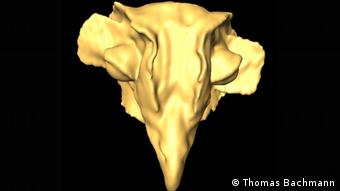 CT image of the head of an owl
X . III
attractions physics concept flying in the air
In everyday life Bernoulli's Law has a diverse application of that has to do with the flow of fluid, either liquid or gas flow. Implementation was used mostly in the fields of engineering and science related to fluid flow. For example in aircraft technology Bernoulli's Law is being used to design an airplane wing design. In other areas, for example the design of the form of fuel-efficient cars, ships and some measuring devices to be used in a speed controller equipment and so on.
Style Lift Aircraft
CT image of the head of an owl
X . III
attractions physics concept flying in the air
In everyday life Bernoulli's Law has a diverse application of that has to do with the flow of fluid, either liquid or gas flow. Implementation was used mostly in the fields of engineering and science related to fluid flow. For example in aircraft technology Bernoulli's Law is being used to design an airplane wing design. In other areas, for example the design of the form of fuel-efficient cars, ships and some measuring devices to be used in a speed controller equipment and so on.
Style Lift Aircraft
The airplane has a wing-like shape of the wings of birds, which is curved and thicker at the front than at the back. This is called the shape of the wing airfoil. Unlike bird wings, wing aircraft can not be in the flap - flutter. Therefore, the air must be maintained through both wings of an airplane. This is done by moving the aircraft engine aircraft developed to meet the air. Aircraft engine old propeller engines, while the use of modern jet engines. Aircraft may be lifted upwards when the lifting force is greater than the weight of the aircraft.We will discuss the lifting force on an airplane wing using the Bernoulli equation. For that, we consider the form of an airplane wing such that current lines airflow through the wing is fixed (streamlined). Cross section of an airplane wing has a sharper rear and side parts of more curved than the bottom. This shape causes the airflow at the top is greater than at the bottom (v2> v1).Of the Bernoulli equation we get:
P1 + ½ + ρ g ρ.v12 h1 = P2 + ½ + ρ g h2 ρ.v22
Altitude both wings can be considered equal (h1 = h2), so that ρ = ρ g g h1 h2. And the above equation can be written:
P1 + P2 + ½ ρ.v12 = ½ ρ.v22
P1 - P2 = ρ.v22 ½ - ½ ρ.v12
P1 - P2 = ½ ρ (v22 - v12)
From the equation above it can be seen that v2> v1 we get P1> P2 to wing section area F1 = P1. A and F2 = P2. A and we get that F1> F2. Different styles on the bottom and top (F1 - F2) produces lift on the aircraft. Thus, the lifting force plane is defined as:
F1 - F2 = ½ ρ A (v22 - v12)With ρ = density of air (kg / m3).
Style-style are Working on AircraftFrom
some of the things, the good performance of pilots on a flight depends
on the ability to plan and coordinate the use of energy (power) and
control of the aircraft to change the style of thrust (thrust), style
hold (drag), lift (elevator) and the weight of the aircraft (weight). The balance of forces is exactly what should be controlled by the pilot. The better understanding of the forces and their control, the better the skills of a pilot.Here are the things that define these forces in a low straight and flat, not accelerated (stright and level, un accelerated).Thrust, is thrust, generated by the engine (power plant) / propeller. This style is the opposite of the resistant force (drag). As a general rule, thrust into action parallel to the longitudinal axis. However, this is not always the case.Drag, is the force behind, withdraw, and is caused by disruption of air flow by the wing, fuselage, and other objects. Drag opposes thrust, and acts rearward parallel to the relative wind (relative wind).Weight, gravity is the combined weight of the load of the airplane, crew, fuel, and cargo or luggage. Weight pulls the plane down because of gravity. Weight against elevator (lift) and acts vertically downward through the center of gravity of the aircraft.Lift, (lift) against the force of the weight, and is produced by the
dynamic effect of the air acting on the wing, and acts perpendicular to
the direction of flight through the center of lift of the wing.In steady flight, the amount of force that is opposing is equal to zero. There will be no imbalance in steady flight and straight (Newton's third law). This applies to horizontal flight or climbing or descending. This is not the same as saying the four forces are equal. Simply put all the opposing forces are equal and cancel out the effect of each style. Often the relationship between these four forces described by one or illustratedin such a way that it becomes less clear.Consider the following picture as an example. In the illustration at the top, the value of all vector-style look the same. The usual explanation states (without stating that thrust and drag do not equal weight and lift) that thrust .
 equals drag and lift equals weight as shown in the illustration below.Basically this is a true statement that should really be understood or would give a misleading notion.It
should be understood that in a straight and horizontal flight (straight
and level), - no berakselerasi-, is a true force lift / weight
opposites are the same, but the style was also greater than the opposing
force of thrust / drag are also equal in value between both, not compared with the lift / weight. For the truth, it must be said that in a stable state (steady):1. The amount of the upward force (not just lift) equal to the amount of downward force (not just weight)2. The amount of thrust (not just thrust) is equal to the amount of force to the back (not just drag).
equals drag and lift equals weight as shown in the illustration below.Basically this is a true statement that should really be understood or would give a misleading notion.It
should be understood that in a straight and horizontal flight (straight
and level), - no berakselerasi-, is a true force lift / weight
opposites are the same, but the style was also greater than the opposing
force of thrust / drag are also equal in value between both, not compared with the lift / weight. For the truth, it must be said that in a stable state (steady):1. The amount of the upward force (not just lift) equal to the amount of downward force (not just weight)2. The amount of thrust (not just thrust) is equal to the amount of force to the back (not just drag).
Performance Flying BirdsThere are 4 types of styles involved:1. Drag Force, the air drag. This style comes from the collision of air molecules with the body of the bird. Direction of the force is always opposite to the direction of motion of birds. While the size of the force is very dependent on the surface area of birds and bird speed. The more surface area the greater the force inhibitory birds. The faster the bird moves, the greater the force of this inhibitory. An illustration to describe the drag-force (resistance) this air is perceived barriers when we walk against the wind blowing. These barriers are increasingly felt great when we open our arms wide
open (extending surface of our body) or when we move faster.2. Lift Force (lift) is a style that lift the bird up. There are two things that can cause this lift force: the fluttering of wings and airflow over the wings. When
birds flapping wings down, the birds of air pressing down, as a result
of air will push back and push the bird up (the law of action-reaction).
The faster the beating of wings, the greater the force on it. That is why pigeons take flight wings will pack an quickly. Heavy bird like Kori Bustard of Africa must necessarily have a strong
chest muscles so that they can more quickly flapping wings to lift his
large frame (19 kg).
air stream flowing over the top of the wing will move faster because the air must be routed further. As a result, the pressure section
This is smaller than the air pressure below the wing.
This pressure difference gives lift to the birds. more and more
curve (the more aerodynamic) wing the greater the force it up.
3. Thrust (thrust) is the force that drives the birds moving forward.
This style is generated by flapping wings that move like the number 8
fall (viewed from the side). Flapping wing generates a vortex
air (vortex) which can provide a boost for the birds
to move forward in the air. The amount of thrust is very
depending on the muscle strength to fly.
4. Weight (gravity) that the gravitational pull of the earth. The amount so
depending on the mass of birds. Its direction is vertically downward.
 style style in birds during flight
style style in birds during flight
The combination of all four styles have used birds to perform a
variety of attractions such as parachutting (motion parachute), Gliding
(gliding), flight (flying forward), and soaring (rising).Parachuting (parachute motion)Motion parachute is falling motion of the air (can be tilted can also be vertical). Tilt angle is greater than 45 ° to the horizontal line. To exercise parachute, the eagle must increase inhibitory force (drag
force) way is to increase the surface area (for example, by spreading
its wings).Gliding (glide)Gliding (slide) motion which falls at an angle less than 45 ° with a horizontal line. The main focus in gliding is gliding as flat as possible. This is done by reducing the air drag. In doing Fulmar bird gliding to a distance of 8.5 meters horizontally but only down 1 meter only. Vultures (Vultures) better, these birds can travel a horizontal distance 22 meters distance with drops only 1 meter.Flight (Flying)Flight movement (fly) performed by the flapping wings. flutterwings used to generate forward thrust force (thrust) and stylelift (elevator). The
thrust and lift force can be set by the birds to control direction,
speed, and altitude when the owl down at high speed to catch rats, owls
shrink drag force to streamline his body or bend the wings. When it was close to its prey (to land), owl slowing its movement by increasing the drag force is to develop wings.Soaring (motion soar)Motion rose is a rose without flapping motion. This movement can be done using air currents. As
a result of the sun heating the air temperature near the earth's
surface becomes hotter, the heat will rise up and cause the air flow to
the top. Air flow is utilized by an eagle to soar without beat great wings. Gulls or albatross, another. To soar, gulls utilize air currents reflected by the surface of the sea. That's why seagulls always come near to the sea surface.Why chickens can not fly properly birds?Some of the factors are as follows:1. The large size and small wings compared her size.2. Chicken body weight because their bones contain a lot of marrow,
unlike the bird aviator whose bones had plenty of empty cavity.3. chicken breast muscles do not develop properly, so its ability flapping weakly.4. Birds have the coffers of the air is used to breathe while flying while chickens do not have any such desires coffers coffers
The
fundamental difference between chickens and birds, chickens have a
structure or arrangement of feathers on the wings are very different
from the birds. In
chickens, the proportion of the size of their wings (when unfolded) to
the great weight and their bodies are not big enough, so with great
muscular strength was difficult for them to fly. In other words, because they poultry wing lift force is smaller than the weight of the birds. Moreover, if the chicken is free-range chicken or beef, it can be guaranteed, he will not be able to lift her into the air.
Unlike
the birds, birds that can fly has a wide wing structure, the
composition of feathers is strong and tight, and the size of the body
that is lightweight and relatively small. Some birds have small wings, hummingbird, for example. But, vibration of its wings very fast up until not visible to the eye. When
the chicken can beat their wings as fast as a hummingbird, guaranteed
he can fly, but the fur will fall out and fly everywhere, because it is
not designed specifically chicken wings to fly.
X . IIII
Bionic Bird, Bird Drone
Now has come the drone new style that takes the form of a bird. The Drone is Bionic Bird who has the ability to fly much like a real bird.
Bionic Bird had a figure like a black bird with a wing span of up to 36 cm. To accommodate the low, such drones only weighs 90 grams.
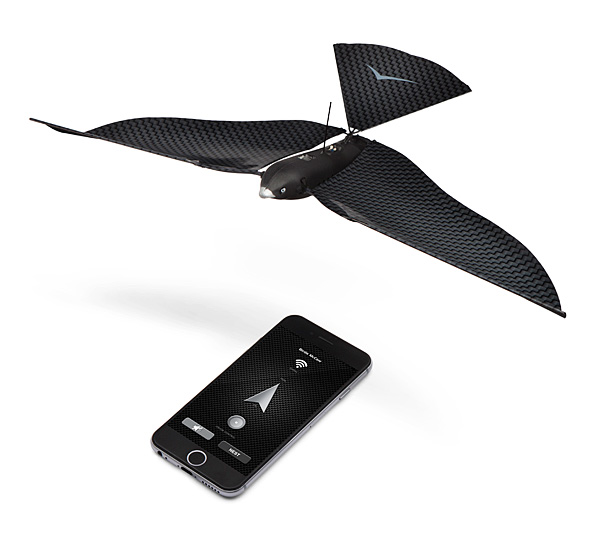 Bionic Bird can fly for 10 minutes in the air. You can control it with a smartphone connected via Bluetooth. The signal range is a maximum of 100 meters.
Bionic Bird can fly for 10 minutes in the air. You can control it with a smartphone connected via Bluetooth. The signal range is a maximum of 100 meters.
Drone this bird looks no different from a real bird when flying. Flapping wings and maneuverability would probably make anyone think it was not a drone.
In addition to offering low outside, Bionic Bird also allows flight in the room. No need to worry about falling or crashing because weight is so light to minimize potential damage.
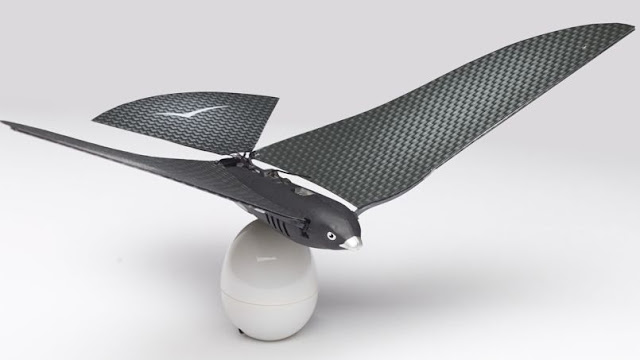 Egg-shaped portable charger for fast charging
Egg-shaped portable charger for fast charging




















